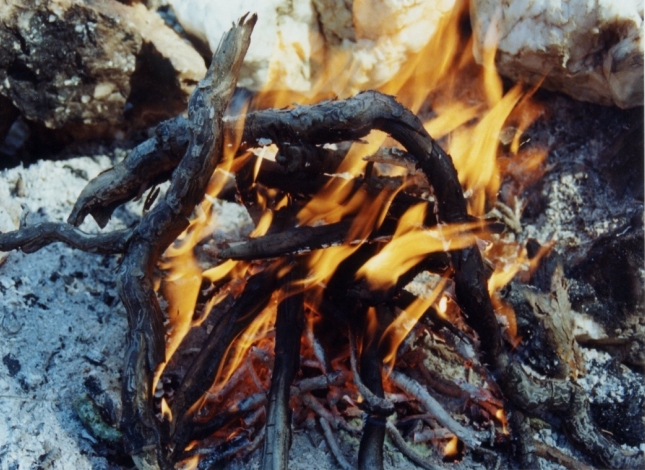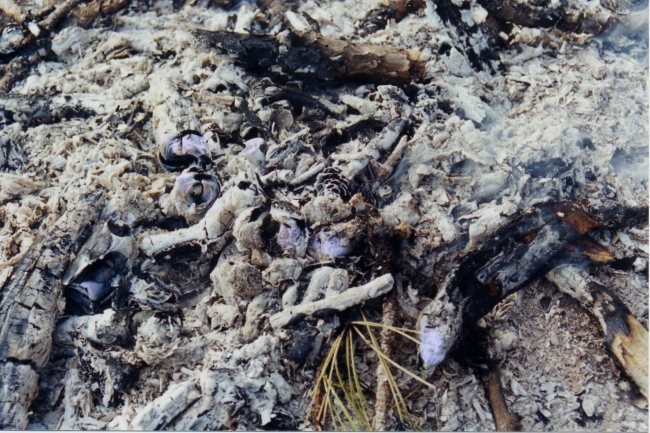This was penned during a Winter trip to Beaver's Bend, a state park in Oklahoma and my Inspirational Place.
To start a fire:
You can try to light leaves and pine needles. That is, if you're a purist. Personally, I use two or three wads of newspaper with the leaves and pine needles on top. Better to be a warm cheater than a cold purist. . .
Always have something handy to fan the initial fire. Fires start like old carbureted engines - very quickly but immediately followed by a slump. The engine needs to have the gas pedal pumped; the fire needs to be fanned.
Also, place some intermediate twigs - about 1/2 inch or so - to help the fire make the transition to larger pieces. It won't go straight from kindling to logs with this damp wood. You'll lose 'er.
You wonder if the energy you get out of a fire is anywhere near the amount of energy expended in keeping it going - what with all the scouting for dead branches, breaking them up, placing a few on the fire every half hour or so, and moving constantly to get out of the way of the smoke.
Late in the day I poke and prod the fire in order to coax a little extra life out of it, but the fire objects by issuing a big plume of smoke instead of the flames I wanted. After a little bit, the fire grants me my flames - but only in its own time. I suppose that's how it is with time; we humans seem to be always out of sync with the time of other things. Is that what Krishna meant? Is that what is meant by the business of releasing the fruits of action? Sooner or later the flames will come if we can just learn to be patient with the smoke.
In any case the flames don't last long. The fire is tired - having been busy since early this morning. It just wants to let its tired white bones settle into the soft pile of ashes. I cheat by placing some young thin twigs on top. I get my flames again. But the old logs and white bones do not participate.
After a while the clicking flames from the new twigs stop, and they sift quietly into the snowy pile. In the silence I leave the fire, saying goodbye and thanking it for the life it has given me throughout the day. I have my stacks of new twigs and branches set aside for tomorrow.
The next morning
The new fire starts more easily - the wood is somewhat dried out now, though still damp from the morning dew.
|
Young fires have an upright pyramidal stance, with a bright red heart and little smoke. This is where I found that I have to watch the transition from smaller kindling to bigger logs. The roaring flame quickly died out and I had to scramble to insert some intermediate twigs under the bigger pieces. Occasional fanning was needed to bring back the flames - the gas pedal had to be pumped. |
Young fires |
 |
Winter fires
Fires create a pleasant collection of quiet sounds (that can only be appreciated by being present to a campfire in the silent winter season). There is the gentle ticking sound that serves as a background theme, as well as by an occasional flame flapping against the small logs as if the flames were tiny flags. The resin in a twig sizzles quietly as would a pot of stew on a stove.
The fire creaks and pops as if it were some old master wheezing gently to ask its student to stop for a moment and ponder its ancient wisdoms. It is evening; the winds of the day have subsided and the lake gently caresses the shoreline, leaving the fire as the only live thing amid the cloudy winter silence.
The drone of some distant engine fades in the distance. When its sounds are gone, there is a palpable relief, as if the silence compels you to relax and listen to the sounds of the ages. This is what life really is; this is where you listen to Existence, and realize that the rest is just a game.
Winter is the quiet season.
The final evening
The fires bones have blue spinal cords |
The last logs become black and then white and settle softly into the snowy cone of ashes. Some burned fissures are a beautiful iridescent blue, and there are blues in the ash pile. It is the last evening now. The inspirational week is over and is sadly transferred to memory, where it settles into old neuronal bones, to be recalled from time to time later when some fresh events stir up the synaptic ash pile. |
 |
Copyright © 2018 J.A.